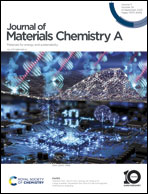Sodium ion doped graphitic carbon nitride with high crystallinity for superior photocatalytic hydrogen evolution efficiency†
Abstract
As a promising photocatalyst for solar-light driven H2 generation, graphitic carbon nitride (GCN) has been intensively investigated for more than ten years. Herein, highly crystalline Na+-doped GCN (GCN-Na) and NH4Cl-assisted Na+-doped GCN (GCN-Na-NH4Cl) were successfully synthesized. A 25-fold and 65-fold increase in the photocatalytic hydrogen evolution (PHE) rate for GCN-Na and GCN-Na-NH4Cl was achieved compared with pristine GCN under visible light irradiation (λ ≥ 420 nm). Furthermore, the short duration time of the long-lived electron for GCN-Na and GCN-Na-NH4Cl indicated their efficient electron utilization. Apart from the structure and optoelectronic property characterization, femtosecond transient absorption spectroscopy (fs-TAS) was performed to investigate the association between the crystallinity and the PHE performance. The fs-TAS measurements at low excitation density reveal a trap-assisted recombination (tens of picoseconds, ps) of the photogenerated electrons for GCN, GCN-Na and GCN-Na-NH4Cl dispersions, and further suggest that GCN-Na and GCN-Na-NH4Cl possess higher density of shallow-trap sites and their energy level is even closer to the conduction band when compared to that of GCN. Moreover, a strong pump density dependence of the photogenerated electron decay kinetics is observed for GCN-Na and GCN-Na-NH4Cl, indicating a rapid Auger recombination (less than 1 ps) occurring in them under intense illumination. Electrons from the shallower-trap-site as well as electrons from the Auger process would participate in PHE, resulting in a remarkably improved PHE activity for GCN-Na and GCN-Na-NH4Cl. This work not only provides insights into the superior PHE efficiency in highly crystalline GCN but also an NH4Cl-assisted calcination method for the preparation of metal-ion doped GCN with high crystallinity.



 Please wait while we load your content...
Please wait while we load your content...